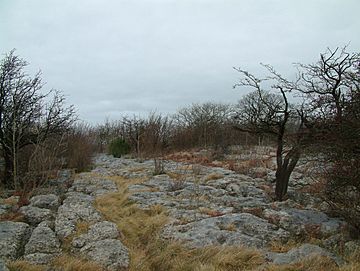Hutton Roof Crags facts for kids
Quick facts for kids Hutton Roof Crags |
|
|---|---|

Limestone pavement on the top of Hutton Roof Crags
|
|
| Highest point | |
| Elevation | 274 m (899 ft) |
| Prominence | c. 176 m (577 ft) |
| Parent peak | Grayrigg Forest |
| Listing | Marilyn |
| Geography | |
| Location | Cumbria, England |
| OS grid | SD556775 |
| Topo map | OS Landranger 97 |
Hutton Roof Crags is a special hill in south-eastern Cumbria, England. It's famous for its huge areas of limestone pavement, which look like giant stone paving slabs. This hill is near the village of Hutton Roof.
Hutton Roof Crags is not just a hill; it's also a very important natural area. It's protected as a Site of Special Scientific Interest (SSSI). This means it has special plants, animals, or geology that needs to be looked after. It's also part of the Morecambe Bay Pavements Special Area of Conservation. This is an even bigger protection for important natural places in Europe.
A lot of the UK's limestone pavement can be found here. You can see it on Hutton Roof Crags and a nearby hill called Farleton Knott.
Contents
What is Limestone Pavement?
Limestone pavement looks like a giant, natural jigsaw puzzle made of stone. It forms when limestone rock is worn away by rain and ice. This creates deep cracks, called "grikes," and flat blocks, called "clints."
How Limestone Pavement Forms
The limestone rock at Hutton Roof Crags is very old. It formed about 350 million years ago during the Carboniferous period. Back then, this area was covered by a warm, shallow sea. Tiny sea creatures died and their shells piled up, forming thick layers of limestone. Over millions of years, this rock was lifted up to form hills. Rainwater, which is slightly acidic, slowly dissolved parts of the limestone. This created the unique patterns we see today.
Protecting the Pavement
In the past, people used to remove parts of the limestone pavement. They used it for building, as fertiliser for farms, or even to make millstones. Luckily, this is now against the law. The limestone pavement at Hutton Roof Crags is protected, so it can't be removed anymore.
Exploring Hutton Roof Crags
Even though some parts of the hill are used for grazing sheep or have forests, much of it is open land. This open land is called common land, which means many people can use it. This is where you'll find most of the amazing limestone pavement.
Managing the Land
The Hutton Roof National Nature Reserve is looked after by the Cumbria Wildlife Trust. They work to protect the special wildlife and habitats here. They manage areas like Park Wood and Hutton Roof Common.
Getting There
You can visit Hutton Roof Crags using public footpaths. One path goes across the north side of the hill. Another way, which might be easier, is through the woods to the south-west.
Bouldering Fun
The low, rocky outcrops of limestone at Hutton Roof Crags are popular for bouldering. Bouldering is a type of rock climbing done on small rocks or boulders, usually without ropes. It's a fun way to explore the unique rock formations.
Amazing Plants and Wildlife
Hutton Roof Crags is home to many interesting plants. Some of these plants are quite rare in other parts of the UK.
Unique Plant Life
You can find special plants growing on the limestone pavement. These include:
- Angular Solomon's seal (Polygonatum odoratum)
- Limestone fern (Gymnocarpium robertianum)
- Dark red helleborine (Epipactis atrorubens)
Two plants that are nationally scarce but grow in large numbers here are:
- Rigid buckler-fern (Dryopteris submontana)
- Blue moor-grass (Sesleria caerulea)
These plants thrive in the unique conditions of the limestone pavement.
What's in a Name?
The name "Hutton Roof Crags" comes from the Old English language. It means 'crags on a hill near the farmstead of Rolf'. This tells us a bit about the history of the area and how it was named long ago.

